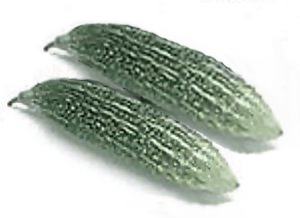|
 Ampalaya (Bitter Melon) with a scientific name
Momordica charantia, is a climbing vine and the tendrils
of which
grow up to 20 centimeters long. This herbal plant belongs to the
family of Cucurbitaceae, and it is a tropical as well as a
subtropical vine. Ampalaya leaves are heart-shaped, which are 5 to
10 centimeters in diameter. The fruits of the ampalaya vine are
fleshy green with pointed ends at length. It can never be mistaken
for any other variety because its ribbed and wrinkled surface had
always been ampalayas distinct physical structure. The bitter taste
of the ampalaya fruit had also been the distinguishing factor from
the rest of the fruits with medicinal value, and this is due to the
presence of a substance known as momorcidin. Ampalaya (Bitter Melon) with a scientific name
Momordica charantia, is a climbing vine and the tendrils
of which
grow up to 20 centimeters long. This herbal plant belongs to the
family of Cucurbitaceae, and it is a tropical as well as a
subtropical vine. Ampalaya leaves are heart-shaped, which are 5 to
10 centimeters in diameter. The fruits of the ampalaya vine are
fleshy green with pointed ends at length. It can never be mistaken
for any other variety because its ribbed and wrinkled surface had
always been ampalayas distinct physical structure. The bitter taste
of the ampalaya fruit had also been the distinguishing factor from
the rest of the fruits with medicinal value, and this is due to the
presence of a substance known as momorcidin.
Ampalaya has been a folkloric cure for generations but
has now been proven to be an effective herbal medicine for many
aliments. Most significant of which is for Diabetes. The Philippine
variety has proven to be most potent. Ampalaya contains a mixture of
flavanoids and alkaloids make the Pancreas produce more insulin that
controls the blood sugar in diabetics. Aside from Ampalaya's
medicinal value, it is good source of vitamins A, B and C, iron,
folic acid, phosphorous and calcium.
Ampalaya has been for used even by the Chinese for centuries. The
effectively of Ampalaya as an herbal medicine has been tried and
tested by many research clinics and laboratories worldwide. In the
Philippines, the Department of Health has endorsed Ampalaya as an
alternative medicine to help alleviate various ailments including
diabetes, liver problems and even HIV. Aside from these, ampalaya
also helps treat skin diseases and cough. Its herbal value extends
to increasing the sterility of women, in parasiticide, antipyretic,
and has purgative functions, as well. Note: In large dozes, pure
Ampalaya juice can be a purgative and abortifacient.
|
|
Herbal Benefits of Ampalaya:
Good for rheumatism and gout
And diseases of the spleen and liver
Aids in lowering blood sugar levels
Helps in lowering blood pressure
Relives headaches
Disinfects and heals wounds & burns
Can be used as a cough & fever remedy
Treatment of intestinal worms, diarrhea
Helps prevent some types of cancer
Enhances immune system to fight infection
For treatment of hemorrhoids
Is an antioxidant and parasiticide
Is antibacterial and antipyretic |
Preparation & Use of Ampalaya:
For coughs, fever, worms, diarrhea, diabetes, juice
Ampalaya leaves and drink a spoonful daily.
For other ailments, the fruit and leaves can both be juiced and
taken orally.
For headaches wounds, burns and skin diseases, apply warmed leaves
to afflicted area.
Powdered leaves, and the root decoction, may be used as
stringent and applied to treat hemorrhoids.
Internal parasites are proven to be expelled when the ampalaya juice,
made from its leaves, is extracted. The ampalaya juice, and grounded
seeds is to be taken one spoonful thrice a day, which also treats
diarrhea, dysentery, and chronic colitis. |

 Ampalaya (Bitter Melon) with a scientific name
Momordica charantia, is a climbing vine and the tendrils
of which
grow up to 20 centimeters long. This herbal plant belongs to the
family of Cucurbitaceae, and it is a tropical as well as a
subtropical vine. Ampalaya leaves are heart-shaped, which are 5 to
10 centimeters in diameter. The fruits of the ampalaya vine are
fleshy green with pointed ends at length. It can never be mistaken
for any other variety because its ribbed and wrinkled surface had
always been ampalayas distinct physical structure. The bitter taste
of the ampalaya fruit had also been the distinguishing factor from
the rest of the fruits with medicinal value, and this is due to the
presence of a substance known as momorcidin.
Ampalaya (Bitter Melon) with a scientific name
Momordica charantia, is a climbing vine and the tendrils
of which
grow up to 20 centimeters long. This herbal plant belongs to the
family of Cucurbitaceae, and it is a tropical as well as a
subtropical vine. Ampalaya leaves are heart-shaped, which are 5 to
10 centimeters in diameter. The fruits of the ampalaya vine are
fleshy green with pointed ends at length. It can never be mistaken
for any other variety because its ribbed and wrinkled surface had
always been ampalayas distinct physical structure. The bitter taste
of the ampalaya fruit had also been the distinguishing factor from
the rest of the fruits with medicinal value, and this is due to the
presence of a substance known as momorcidin.